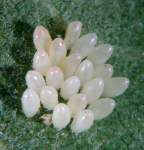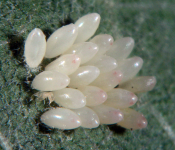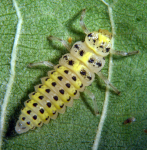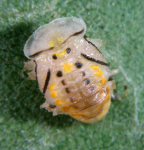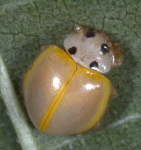 |
Scientific nameIlleis cincta (Fabricius) (=Thea cincta (Fabricius))
Taxonomic positionColeoptera: Coccinellidae: Coccinellinae: Coccinellini
DiagnosisLength 4.00-4.68 mm, width 3.05-3.60 mm. Form elongate oval, moderately convex. Head pale luteous to creamy yellow. Eyes separated by more than one eye width. Pronotum with a pair of median black spots on posterior margin; anterior and lateral margins transparent, lateral margins slightly upturned. Elytra bright lemon yellow with transparent lateral margins. Ventral side more or less uniformly yellowish. Antenna (Fig. 2) long, with all segments much longer than broad, with a loosely-jointed,
three-segmented club, last segment spatulate. Male genitalia (Figs. 7-8) and female spermatheca (Fig. 8) as illustrated. Larva lemon yellow, with four longitudinal rows of black spots on dorsal side. Pupa pale yellow with areas of grey and black markings.
Commonly found in association with its close relative, Illeis bielawskii Ghorpade, from which it can be readily separated by the presence of a pair of black spots on pronotum. The elytra of the latter, in addition, are usually with a greyish patch on disk. The male genitalia of I. bielawski are diagnostic. 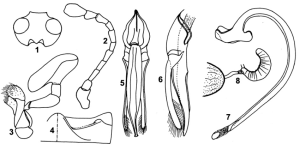 Figs. 1-8. Illeis cincta: 1. Head, dorsal view; 2. Antenna; 3. Maxilla; 4. Postcoxal line on abdominal ventrite 1; 5-7. Male genitalia: 5. Tegmen, ventral view; 6. Tegmen, lateral view; 7. Sipho; 8. Female spermatheca. ImagesDistributionIndia: Andhra Pradesh; Goa; Haryana; Karnataka; Kerala; Maharashtra; Tamil Nadu. Widely distributed in India, but more common in peninsular India.
Prey / Associated habitatOccurs together with Illeis bistigmosa complex. Commonly found feeding on various powdery mildews caused by Phyllactinia corylea, Podosphaera, Sphaerotheca, and Oidium spp., infesting sunflower, mulberry, Xanthium strumarium, cowpea, chillies, Pedulanthus sp., etc. Collected on sorghum, brinjal, pumpkin, cotton, and melon. Several insect prey such as aphids, coccids and mites have been reported in the literature, but apparently these are erroneous.
Seasonal occurrencePresent throughout the year, particularly active in post-rainy season.
Natural enemiesDinocampus coccinellae (Schrank) (Hymenoptera: Braconidae); Nothoserphus
mirabilis Brues (Hymenoptera: Proctotrupidae).
References
|
